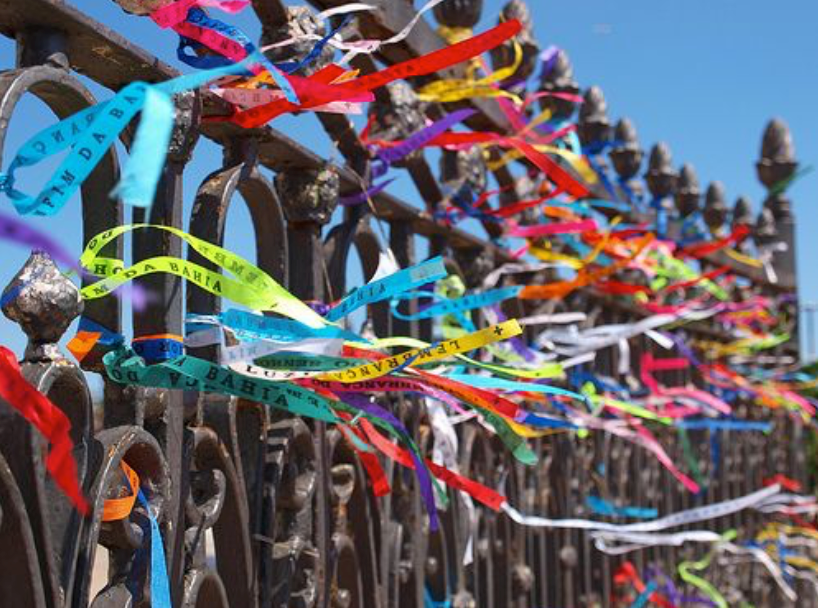
Faith & Fashion
Faith & Fashion by Morgan Watkins
Although styling looks with religious jewelry is not a new concept, it seems to be having a major moment in the fashion universe. The latest Heavenly Bodies Met Gala and exhibit resulted in looks so exquisitely sultry, it should be a sin. But what are the true origins of Catholic inspired fashions, Christian cross necklaces and other religious dressings that have been commodified for the general public to wear? Keep reading to learn more about religious jewelry.
The Cross

Cross necklaces have been a symbol of faith for followers of Christ since the times of the Roman Empire in the 4th century. Not only does this powerful accessory show Christian, or Catholic, faith, but it also serves as a form of spiritual protection for the wearer. These necklaces can also be gifted to individuals at baptisms and confirmation ceremonies, with simple crosses or embellished ones showcasing diamonds and even birthstones. For decades, the spiritual significance associated with cross jewelry has faded as icons in pop culture, like Madonna and Billy Idol, have turned the spiritual items into fashion fads. Cross necklaces have also been worn in political contexts to criticize popular religious beliefs that work towards shaming women for their individuality and sexuality. But no matter the rhyme or reason for wearing necklaces with hanging crosses, a lot can be said about their staying power in the fashion world. Paired beautifully with delicate lace, cross necklaces can create a look so stunning, you’ll be in heaven.
Prayer Jewelry

(Image from https://www.malaprayer.com/blogs/news/everything-you-need-to-know-about-mala-pray er-necklaces)
Prayer jewelry quite possibly holds even more religious significance than cross necklaces, and have not been brought into mainstream fashion as a superficial accessory. Various religions hold onto beaded necklaces representing various purposes. Islamic prayer beads typically have 100 beads, while those of the Baha’i religion have 95 or 19, with a grouping of 5 beads hanging below. Sikhs, Hindus and Buddhists wear what are known as mala prayer necklaces, which are worn not only around the neck, but also around turbans and wrists. Malas typically have 108 beads made of natural materials like sandalwood and lava stone, and are said to have originated in India during the 8th century. Mala became popular in countries like China, Korea and Japan before hitting Europe during the late Middle Ages in the shape of the Catholic rosary. Roman Catholics, like most other religions utilizing prayer beads, used rosaries to count prayers and other acts of worship, as well as provide security. These necklaces characteristically feature 59 beads, but before beads came around, a popular way of keeping track of prayers was by tying knots or fastening berries, pebbles and/or bone discs onto necklaces.
Fita do Senhor do Bonfim

(Image from http://www.sensationalcolor.com/color-meaning/color-meaning-symbolism-psychology/b ahia-bands-brazilian-wish-bracelet#.W7-v8WhKhaQ)
Similar to prayer necklaces, Fita do Senhor do Bonfim, or ribbon of Bonfim, are essentially wish ribbons. Dating back to 1809, the ribbons, also known as Bahia bands, were originated by the African religion of Cadomblé. They were initially called “measure of Bonfim” because their size equated the length of the arm of the Jesus Christ statue perched upon the main altar of the Bonfim Church in Salvador, Brazil. Measuring 47 centimeters long, Bahia bands are commonly worn around the left wrist, on the ankle, around hats and necks, and are even tied to the gate of the Bonfim Church. When tied in three knots, a wish can be made. Customarily, the ribbon is gifted to an individual and is tied to the receiver’s wrist by the gifter. The band must fall off the body naturally over time, or the wish will not come true. These accessories also represent good faith, and the color of the band symbolizes specific orixás, or divine forces of nature. For instance, the color red represents passion and strength, yellow equates to success and intelligence, and orange signifies courage, energy and joy.

Accessories like the ones mentioned above can have deep meaning for a variety of people and cultures around the world.While appreciating the artistic and aesthetic elements of religious styles in fashion isn’t a sin, it is crucial that everyone, from runway connoisseurs and everyday individuals, know and respect the rich history behind the symbols they wear.
References
Coscarelli, Alyssa. “Is It Okay To Wear Religious Symbols For Fashion?” Refinery29, 4 May 2018, https://www.refinery29.com/cross-jewelry-trend.
“Everything You Need to Know about Mala Prayer Necklaces.” Mala Prayer, https://www.malaprayer.com/blogs/news/everything-you-need-to-know-about-mal
A-prayer-necklaces.
Ribeiro, Patricia. “A Traveler’s Guide to Bonfim Church.” Trip Savvy, 30 June 2017, https://www.tripsavvy.com/bonfim-church-salvador-brazil-1467851.
Smith, Katie. “Bahia Bands: Brazilian Bracelet Color Meaning.” Sensational Color, http://www.sensationalcolor.com/color-meaning/color-meaning-symbolism-psych ology/bahia-bands-brazilian-wish-bracelet#.W7-yEGhKhaS.
